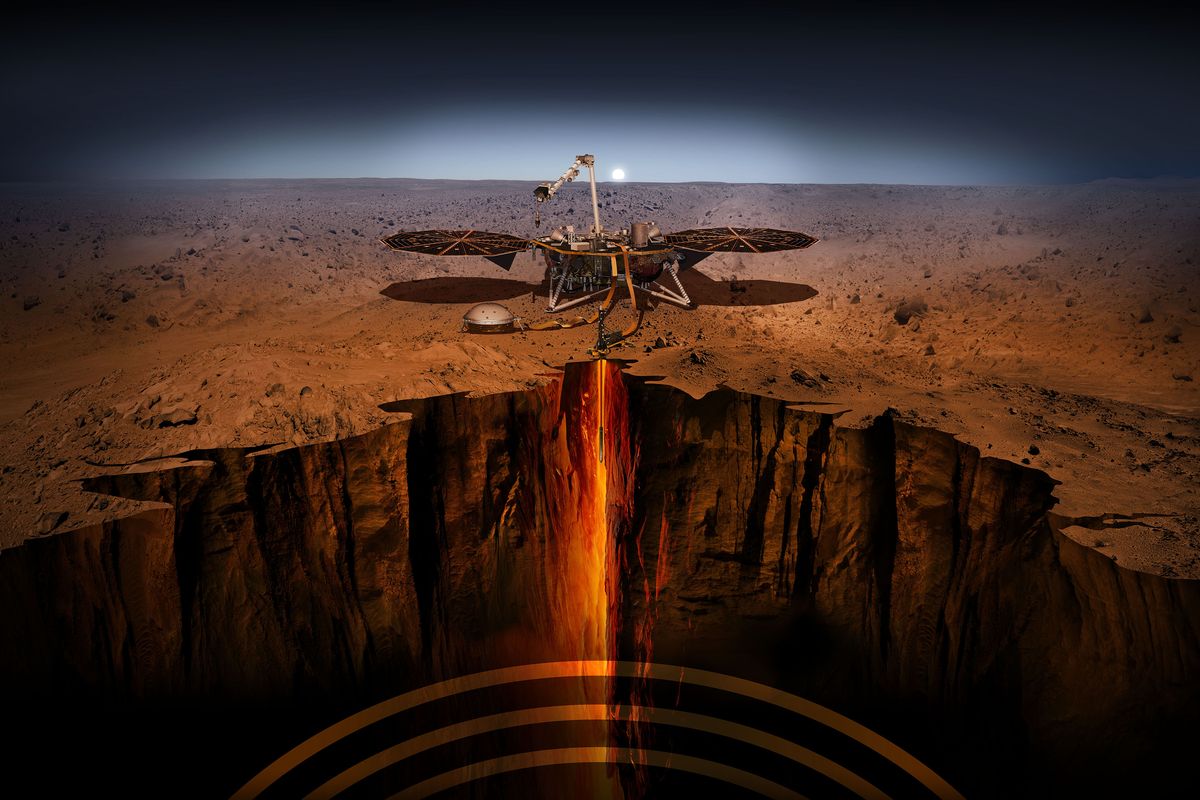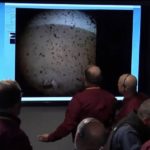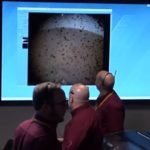

News
NASA’s Mars InSight shares first images from the Red Planet
Confirmed today at 2:53 pm EST, NASA’s InSight lander safely touched down on the surface of Mars. After six years without a visitor, the red planet will now host a seismic investigator from Earth that will study the planet’s core, drilling 10-16 feet down into its crust to gather clues about its early geological history. The scientists responsible for the craft’s development and journey responded to the craft’s mission success with cheers and elation, relieved from the nervous anticipation filling the last few days of preparations and media presentations.
Live stream viewers watched InSight’s team receive the data feed from the craft in real-time, many as part of in-person watch parties hosted at universities and libraries around the world. In publicity events leading up to the landing, NASA scientists anticipated the craft’s images from the Martian surface would not have much visibility due to dust kicked up from the surface activity. This prediction became reality as the first picture sent back from InSight was speckled with dust.
After unfurling its solar panels, InSight will spend the next few weeks carefully unpacking its instruments. Once fully deployed, measurements will be taken at the surface and underground to measure things like thermal conductivity and vibrational speed to study the structure of the planet’s subsurface. Routine operations will start 2-4 weeks after the InSight’s instruments are in place.
- The first photo from InSight received from the surface of Mars. | Credit: NASA/JPL
- InSight phones home with a photo from Mars. | Credit: NASA/JPL
The first photo from InSight received from the surface of Mars. [Credit: NASA/JPL]
InSight, short for “Interior Exploration using Seismic Investigations, Geodesy and Heat Transport”, launched aboard an Atlas V rocket on May 5, 2018 with twin CubeSat companions named “Mars Cube One” (MarCO). The nearly seven-month journey to Mars involved several navigational adjustments to keep it on course for its destination. They also performed various tests to ensure its communication and entry, descent, and landing operations tools were working properly.
MarCO further made history during the journey as the first CubeSats, a class of spacecraft based on a standardized small size, to fly into deep space. The MarCO twins were transmitting as expected up to the start time of the landing sequence and locked onto the craft prior to entry. Telemetry data came in perfectly, continuing to prove the case for tiny machines in deep space.
Unlike its rover neighbors, Spirit and Opportunity, InSight will remain stationary throughout its entire mission. Geographically speaking, even its location on the red planet, the Elysium Planitia, will be uneventful, at times described as “the biggest parking lot on Mars”. However, the location’s lack of luster serves a purpose. InSight’s instruments will need a flat, calm surface to ensure successful operations. Its mission is anticipated to last about two years.
Watch the link below to relive InSight’s team elated response to its landing success:

Elon Musk
SpaceX issues statement on Starship V3 Booster 18 anomaly
The incident unfolded during gas-system pressure testing at the company’s Massey facility in Starbase, Texas.

SpaceX has issued an initial statement about Starship Booster 18’s anomaly early Friday. The incident unfolded during gas-system pressure testing at the company’s Massey facility in Starbase, Texas.
SpaceX’s initial comment
As per SpaceX in a post on its official account on social media platform X, Booster 18 was undergoing gas system pressure tests when the anomaly happened. Despite the nature of the incident, the company emphasized that no propellant was loaded, no engines were installed, and personnel were kept at a safe distance from the booster, resulting in zero injuries.
“Booster 18 suffered an anomaly during gas system pressure testing that we were conducting in advance of structural proof testing. No propellant was on the vehicle, and engines were not yet installed. The teams need time to investigate before we are confident of the cause. No one was injured as we maintain a safe distance for personnel during this type of testing. The site remains clear and we are working plans to safely reenter the site,” SpaceX wrote in its post on X.
Incident and aftermath
Livestream footage from LabPadre showed Booster 18’s lower half crumpling around the liquid oxygen tank area at approximately 4:04 a.m. CT. Subsequent images posted by on-site observers revealed extensive deformation across the booster’s lower structure. Needless to say, spaceflight observers have noted that Booster 18 would likely be a complete loss due to its anomaly.
Booster 18 had rolled out only a day earlier and was one of the first vehicles in the Starship V3 program. The V3 series incorporates structural reinforcements and reliability upgrades intended to prepare Starship for rapid-reuse testing and eventual tower-catch operations. Elon Musk has been optimistic about Starship V3, previously noting on X that the spacecraft might be able to complete initial missions to Mars.
Investor's Corner
Tesla analyst maintains $500 PT, says FSD drives better than humans now
The team also met with Tesla leaders for more than an hour to discuss autonomy, chip development, and upcoming deployment plans.

Tesla (NASDAQ:TSLA) received fresh support from Piper Sandler this week after analysts toured the Fremont Factory and tested the company’s latest Full Self-Driving software. The firm reaffirmed its $500 price target, stating that FSD V14 delivered a notably smooth robotaxi demonstration and may already perform at levels comparable to, if not better than, average human drivers.
The team also met with Tesla leaders for more than an hour to discuss autonomy, chip development, and upcoming deployment plans.
Analysts highlight autonomy progress
During more than 75 minutes of focused discussions, analysts reportedly focused on FSD v14’s updates. Piper Sandler’s team pointed to meaningful strides in perception, object handling, and overall ride smoothness during the robotaxi demo.
The visit also included discussions on updates to Tesla’s in-house chip initiatives, its Optimus program, and the growth of the company’s battery storage business. Analysts noted that Tesla continues refining cost structures and capital expenditure expectations, which are key elements in future margin recovery, as noted in a Yahoo Finance report.
Analyst Alexander Potter noted that “we think FSD is a truly impressive product that is (probably) already better at driving than the average American.” This conclusion was strengthened by what he described as a “flawless robotaxi ride to the hotel.”
Street targets diverge on TSLA
While Piper Sandler stands by its $500 target, it is not the highest estimate on the Street. Wedbush, for one, has a $600 per share price target for TSLA stock.
Other institutions have also weighed in on TSLA stock as of late. HSBC reiterated a Reduce rating with a $131 target, citing a gap between earnings fundamentals and the company’s market value. By contrast, TD Cowen maintained a Buy rating and a $509 target, pointing to strong autonomous driving demonstrations in Austin and the pace of software-driven improvements.
Stifel analysts also lifted their price target for Tesla to $508 per share over the company’s ongoing robotaxi and FSD programs.
Elon Musk
SpaceX Starship Version 3 booster crumples in early testing
Photos of the incident’s aftermath suggest that Booster 18 will likely be retired.

SpaceX’s new Starship first-stage booster, Booster 18, suffered major damage early Friday during its first round of testing in Starbase, Texas, just one day after rolling out of the factory.
Based on videos of the incident, the lower section of the rocket booster appeared to crumple during a pressurization test. Photos of the incident’s aftermath suggest that Booster 18 will likely be retired.
Booster test failure
SpaceX began structural and propellant-system verification tests on Booster 18 Thursday night at the Massey’s Test Site, only a few miles from Starbase’s production facilities, as noted in an Ars Technica report. At 4:04 a.m. CT on Friday, a livestream from LabPadre Space captured the booster’s lower half experiencing a sudden destructive event around its liquid oxygen tank section. Post-incident images, shared on X by @StarshipGazer, showed notable deformation in the booster’s lower structure.
Neither SpaceX nor Elon Musk had commented as of Friday morning, but the vehicle’s condition suggests it is likely a complete loss. This is quite unfortunate, as Booster 18 is already part of the Starship V3 program, which includes design fixes and upgrades intended to improve reliability. While SpaceX maintains a rather rapid Starship production line in Starbase, Booster 18 was generally expected to validate the improvements implemented in the V3 program.
Tight deadlines
SpaceX needs Starship boosters and upper stages to begin demonstrating rapid reuse, tower catches, and early operational Starlink missions over the next two years. More critically, NASA’s Artemis program depends on an on-orbit refueling test in the second half of 2026, a requirement for the vehicle’s expected crewed lunar landing around 2028.
While SpaceX is known for diagnosing failures quickly and returning to testing at unmatched speed, losing the newest-generation booster at the very start of its campaign highlights the immense challenge involved in scaling Starship into a reliable, high-cadence launch system. SpaceX, however, is known for getting things done quickly, so it would not be a surprise if the company manages to figure out what happened to Booster 18 in the near future.










